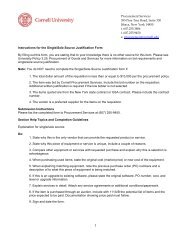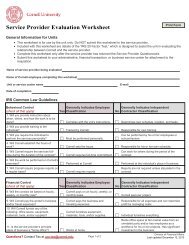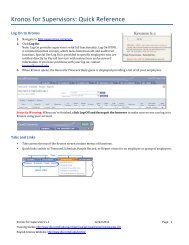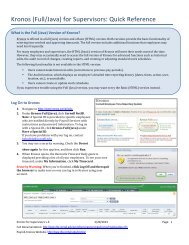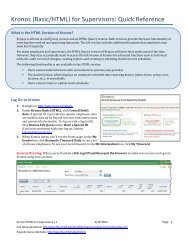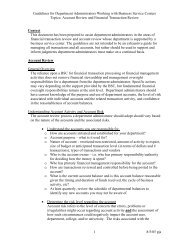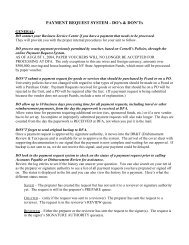Cornell University 2011-2012 Annual Report - DFA Home - Cornell ...
Cornell University 2011-2012 Annual Report - DFA Home - Cornell ...
Cornell University 2011-2012 Annual Report - DFA Home - Cornell ...
Create successful ePaper yourself
Turn your PDF publications into a flip-book with our unique Google optimized e-Paper software.
ResearchResearchers connect geneto pre-Alzheimer’sJuly 18, <strong>2011</strong>—<strong>Cornell</strong> scientists have shown asignificant correlation for the first time between a humangene and people’s risk for mild cognitive impairment,often a precursor to Alzheimer’s disease and relatedforms of dementia. The findings could help doctors torecommend simple preventative measures for at-riskpatients, including healthy diet, exercise, and intellectualactivity—all of which could forestall and even preventchronic symptoms associated with the disease, saidprofessors of human development in the College ofRobots learn to handle objects,understand placesSeptember 1, <strong>2011</strong>—Infants spend their firstfew months learning to find their way around andmanipulating objects, and they are very flexible aboutit: Cups can come in different shapes and sizes, butthey all have handles. So do pitchers, so we pick themup the same way. Similarly, your personal robot in thefuture will need the ability to generalize—for example, tohandle your particular set of dishes and put them in yourprofessor of computer science, is teaching robots tomanipulate objects and find their way around in newenvironments.ERL researchers surpass scientificmilestonesOctober 24, <strong>2011</strong>—<strong>Cornell</strong> scientists have surpassedtwo major scientific milestones toward proving thetechnology of a novel, exceedingly powerful X-rayis now reporting that its prototype electron injector isproducing beams with a so-called emittance of 0.8micrometers—the smallest ever recorded from anelectron source of this type. The injector is the keyelectron beams that are tightly packed and traveling atnearly the speed of light. In another breakthrough forprototype seven-cell superconducting radio frequencyelectrons from the injector to very high energies in orderto produce the X-rays. The SRF cavities are operatedtemperature.Ithaca-NYC collaborationsboost researchOctober 21, <strong>2011</strong>—Collaborations betweenresearchers at Weill <strong>Cornell</strong> Medical College and theIthaca campus yield results that might otherwiseby Robin Davisson, professor of biomedical sciences,who holds appointments on both campuses. ManyMedicine and are important not only for the light theyshed on human ailments but also for better care forbiomedical sciences and director of <strong>Cornell</strong>’s Center forReproductive Genetics, which involves about 100 facultymembers at Ithaca and Weill.Astronomers identify threeextrasolar planetsApril 25, <strong>2012</strong>—It’s not little green men, but it couldbe a step in that direction: <strong>Cornell</strong> astronomers, usingcould be hospitable to life. The team of astronomersused the <strong>Cornell</strong>-built Near-Infrared Triple Spectrographto measure the temperatures and metallicities of smallstars called M dwarfs, first recorded by the NASAsearch for planets outside our solar system, which arecalled extrasolar planets or exoplanets. The team thatbuilt TripleSpec, completed in 2008, was led by TerryHerter, <strong>Cornell</strong> professor of astronomy. The findingswere published online April 23 in Astrophysical JournalAlumni NewsBill Nye ’77 harnesses the sun withRhodes Hall clockAugust 29, <strong>2011</strong>—Hall began to glow against a cloudy bright sky. A crowdof hundreds at Hoy Field cheered. The clock, a gift from42<strong>Annual</strong> <strong>Report</strong> <strong>2011</strong>–<strong>2012</strong>



